Business Report: Intercultural Competences and Hannah's Challenges
VerifiedAdded on 2023/01/09
|7
|1986
|64
Report
AI Summary
This report examines the significance of intercultural competences in a business context, using the case of Hannah and Company to illustrate real-world challenges. The report identifies where Hannah and the company went wrong in a cross-cultural negotiation scenario, highlighting a lack of understanding of Japanese culture and communication styles. It then proposes solutions, including training sessions, workshops, and the development of workplace etiquette to foster cultural awareness and effective communication. The report delves into intercultural theories, particularly Hofstede's cultural dimensions and Handy's culture framework, to analyze the cultural differences between Germany and Japan, offering specific advice to Hannah and the company on how to navigate these differences. The report concludes by emphasizing the importance of valuing other cultures, involving all employees in decision-making, and applying a role culture to achieve business success in a global environment. The report utilizes references to support its findings and recommendations.
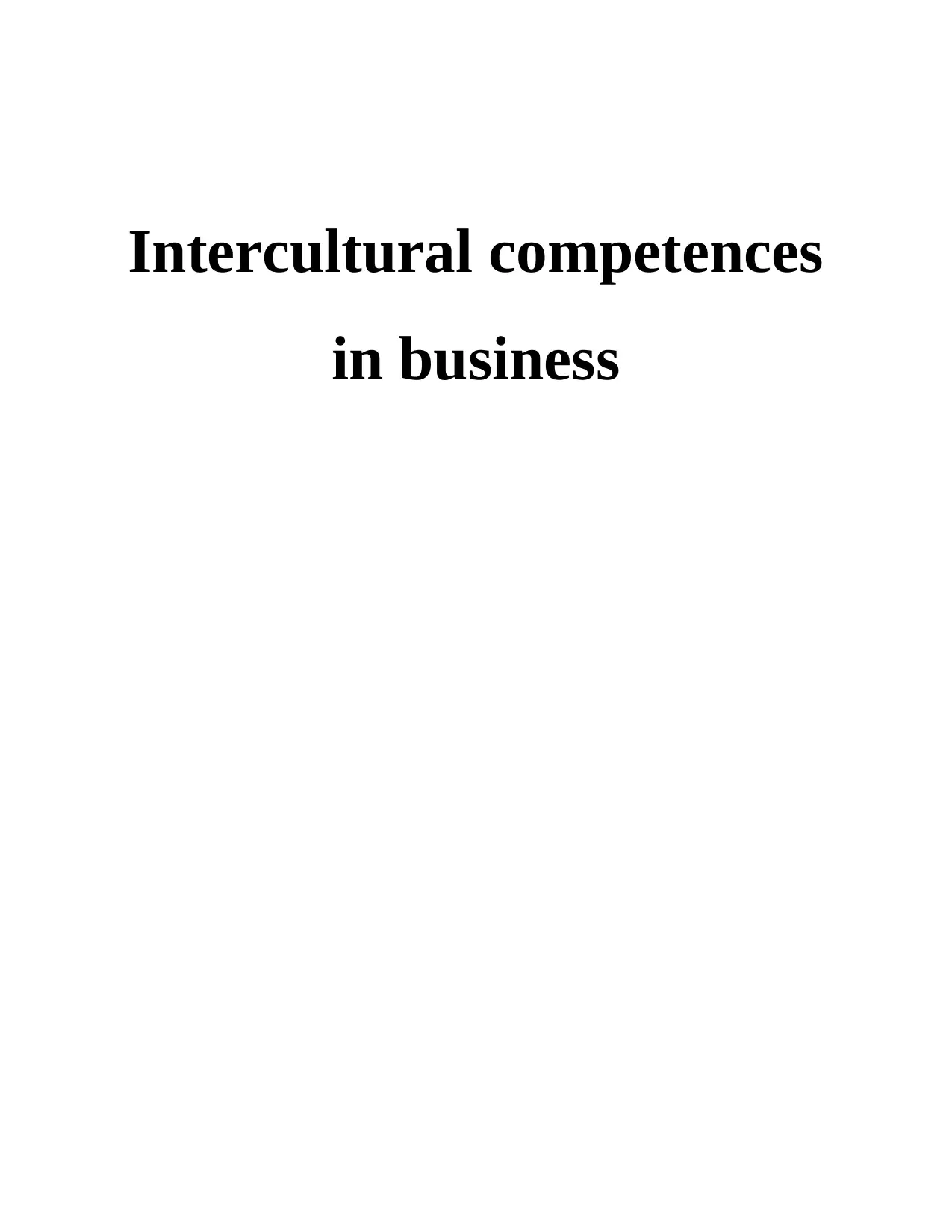
Intercultural competences
in business
in business
Paraphrase This Document
Need a fresh take? Get an instant paraphrase of this document with our AI Paraphraser
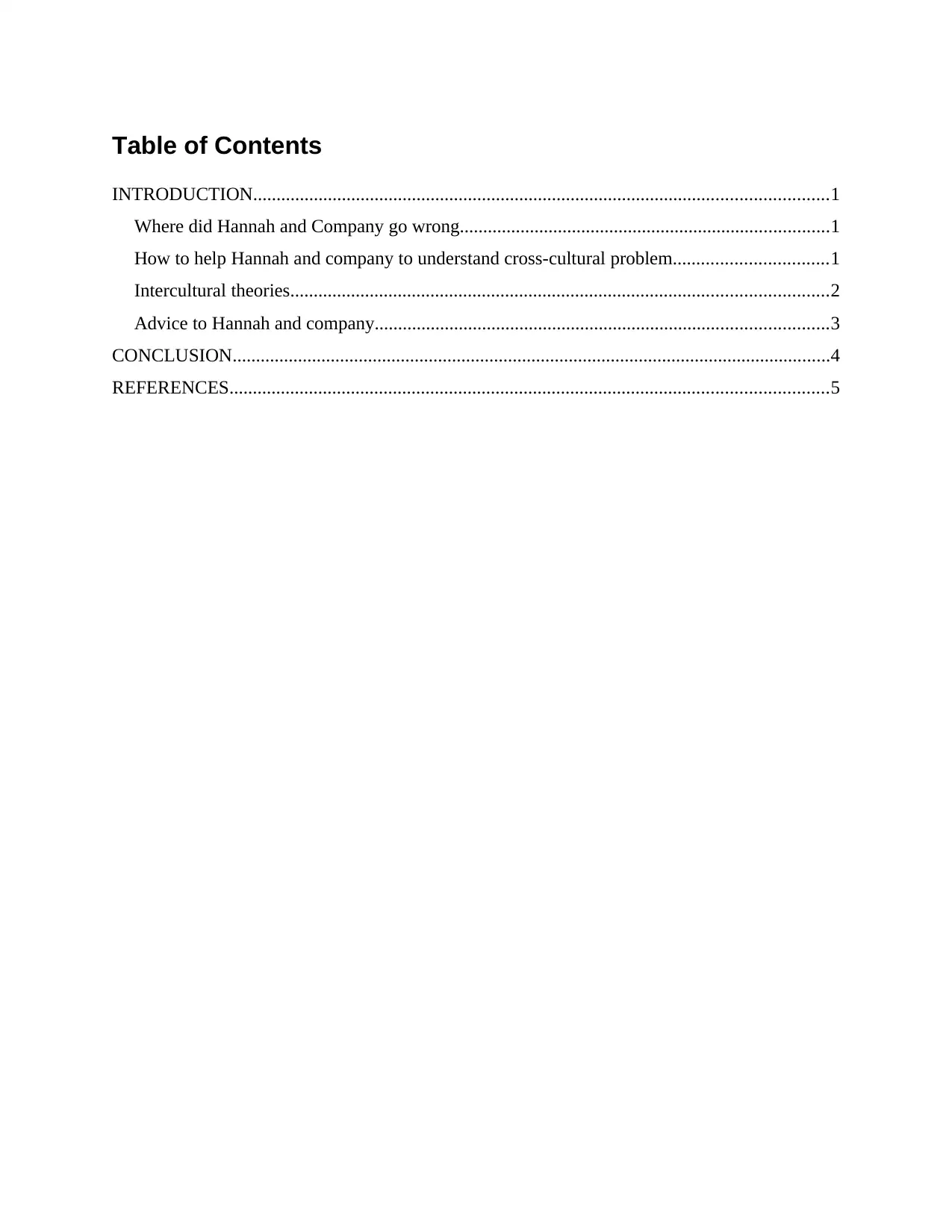
Table of Contents
INTRODUCTION...........................................................................................................................1
Where did Hannah and Company go wrong...............................................................................1
How to help Hannah and company to understand cross-cultural problem.................................1
Intercultural theories...................................................................................................................2
Advice to Hannah and company.................................................................................................3
CONCLUSION................................................................................................................................4
REFERENCES................................................................................................................................5
INTRODUCTION...........................................................................................................................1
Where did Hannah and Company go wrong...............................................................................1
How to help Hannah and company to understand cross-cultural problem.................................1
Intercultural theories...................................................................................................................2
Advice to Hannah and company.................................................................................................3
CONCLUSION................................................................................................................................4
REFERENCES................................................................................................................................5
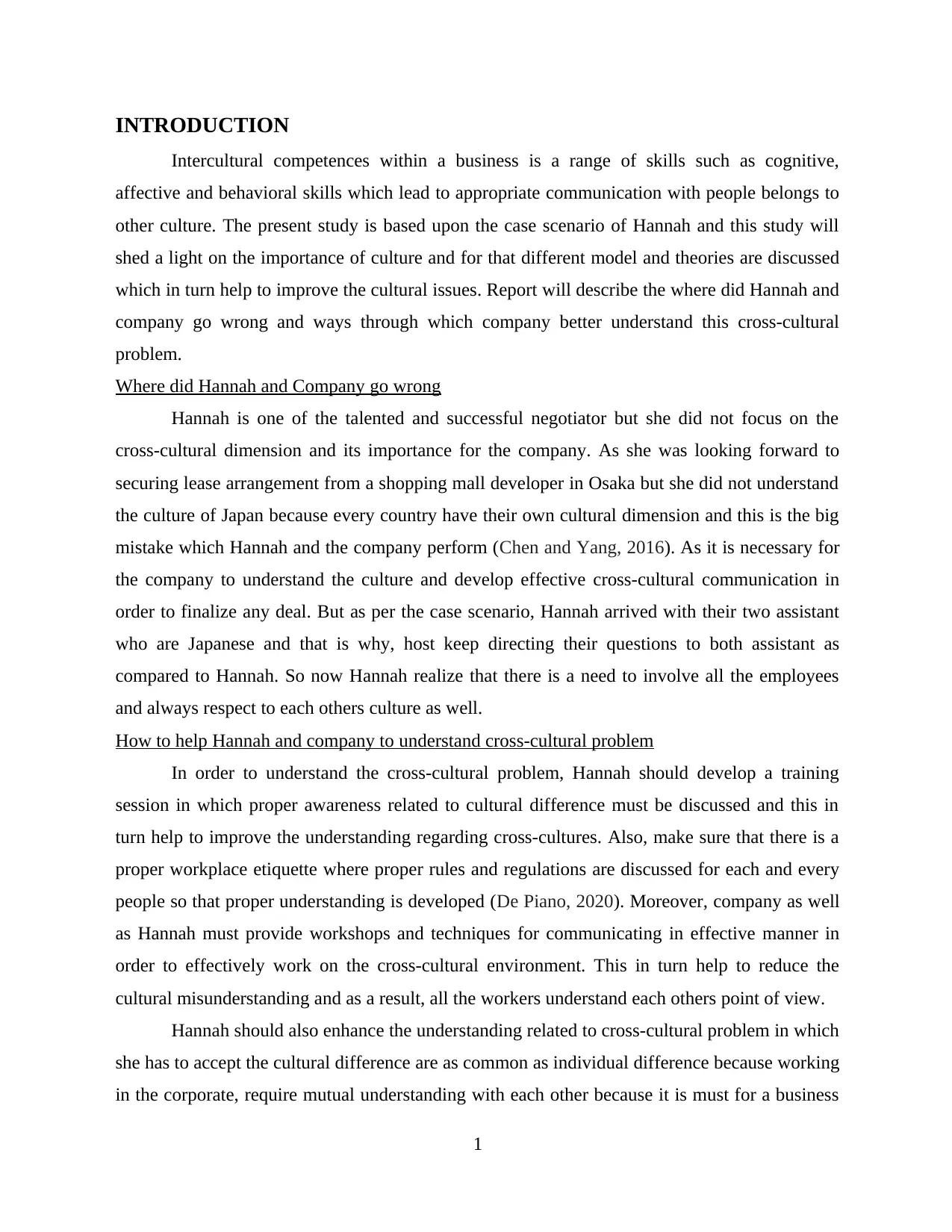
INTRODUCTION
Intercultural competences within a business is a range of skills such as cognitive,
affective and behavioral skills which lead to appropriate communication with people belongs to
other culture. The present study is based upon the case scenario of Hannah and this study will
shed a light on the importance of culture and for that different model and theories are discussed
which in turn help to improve the cultural issues. Report will describe the where did Hannah and
company go wrong and ways through which company better understand this cross-cultural
problem.
Where did Hannah and Company go wrong
Hannah is one of the talented and successful negotiator but she did not focus on the
cross-cultural dimension and its importance for the company. As she was looking forward to
securing lease arrangement from a shopping mall developer in Osaka but she did not understand
the culture of Japan because every country have their own cultural dimension and this is the big
mistake which Hannah and the company perform (Chen and Yang, 2016). As it is necessary for
the company to understand the culture and develop effective cross-cultural communication in
order to finalize any deal. But as per the case scenario, Hannah arrived with their two assistant
who are Japanese and that is why, host keep directing their questions to both assistant as
compared to Hannah. So now Hannah realize that there is a need to involve all the employees
and always respect to each others culture as well.
How to help Hannah and company to understand cross-cultural problem
In order to understand the cross-cultural problem, Hannah should develop a training
session in which proper awareness related to cultural difference must be discussed and this in
turn help to improve the understanding regarding cross-cultures. Also, make sure that there is a
proper workplace etiquette where proper rules and regulations are discussed for each and every
people so that proper understanding is developed (De Piano, 2020). Moreover, company as well
as Hannah must provide workshops and techniques for communicating in effective manner in
order to effectively work on the cross-cultural environment. This in turn help to reduce the
cultural misunderstanding and as a result, all the workers understand each others point of view.
Hannah should also enhance the understanding related to cross-cultural problem in which
she has to accept the cultural difference are as common as individual difference because working
in the corporate, require mutual understanding with each other because it is must for a business
1
Intercultural competences within a business is a range of skills such as cognitive,
affective and behavioral skills which lead to appropriate communication with people belongs to
other culture. The present study is based upon the case scenario of Hannah and this study will
shed a light on the importance of culture and for that different model and theories are discussed
which in turn help to improve the cultural issues. Report will describe the where did Hannah and
company go wrong and ways through which company better understand this cross-cultural
problem.
Where did Hannah and Company go wrong
Hannah is one of the talented and successful negotiator but she did not focus on the
cross-cultural dimension and its importance for the company. As she was looking forward to
securing lease arrangement from a shopping mall developer in Osaka but she did not understand
the culture of Japan because every country have their own cultural dimension and this is the big
mistake which Hannah and the company perform (Chen and Yang, 2016). As it is necessary for
the company to understand the culture and develop effective cross-cultural communication in
order to finalize any deal. But as per the case scenario, Hannah arrived with their two assistant
who are Japanese and that is why, host keep directing their questions to both assistant as
compared to Hannah. So now Hannah realize that there is a need to involve all the employees
and always respect to each others culture as well.
How to help Hannah and company to understand cross-cultural problem
In order to understand the cross-cultural problem, Hannah should develop a training
session in which proper awareness related to cultural difference must be discussed and this in
turn help to improve the understanding regarding cross-cultures. Also, make sure that there is a
proper workplace etiquette where proper rules and regulations are discussed for each and every
people so that proper understanding is developed (De Piano, 2020). Moreover, company as well
as Hannah must provide workshops and techniques for communicating in effective manner in
order to effectively work on the cross-cultural environment. This in turn help to reduce the
cultural misunderstanding and as a result, all the workers understand each others point of view.
Hannah should also enhance the understanding related to cross-cultural problem in which
she has to accept the cultural difference are as common as individual difference because working
in the corporate, require mutual understanding with each other because it is must for a business
1
⊘ This is a preview!⊘
Do you want full access?
Subscribe today to unlock all pages.

Trusted by 1+ million students worldwide
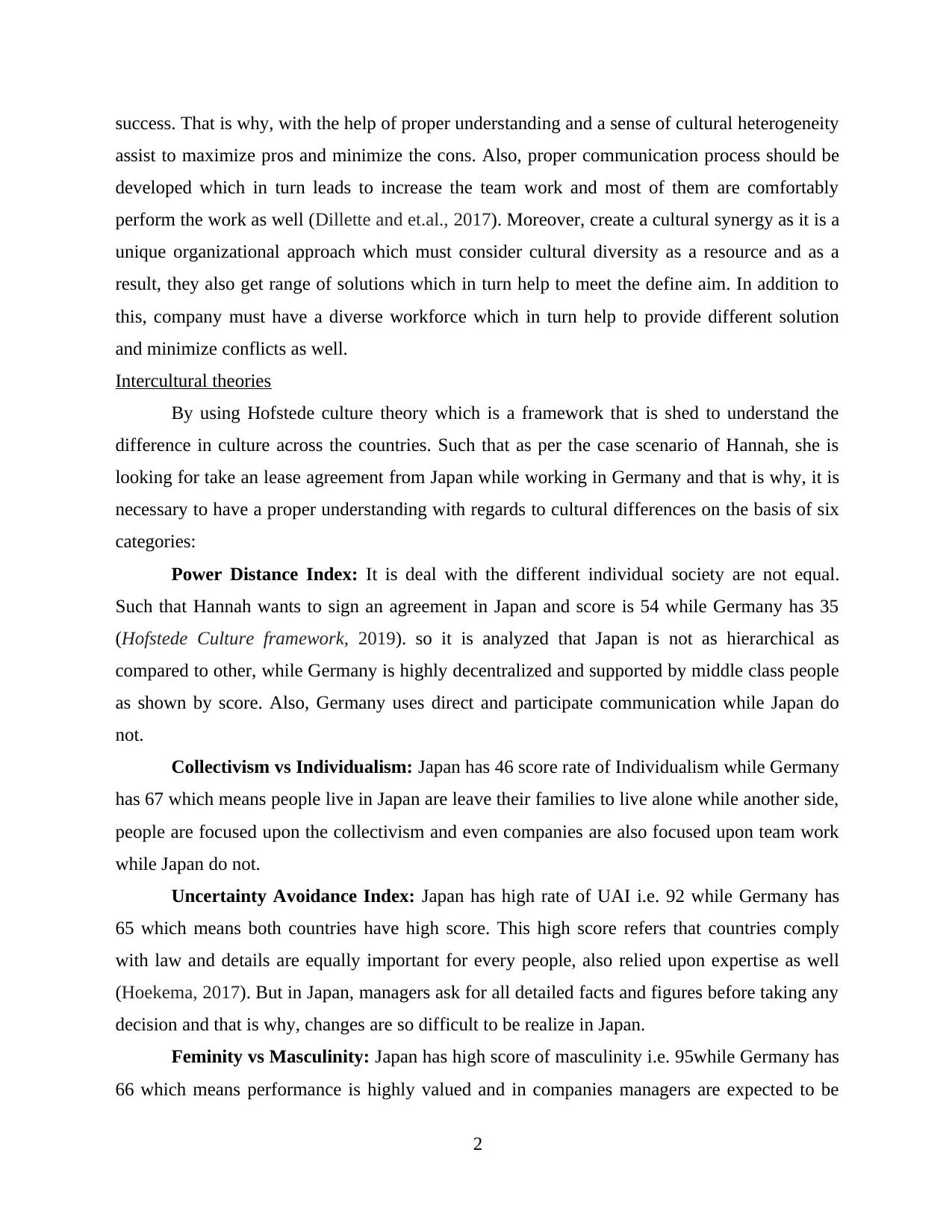
success. That is why, with the help of proper understanding and a sense of cultural heterogeneity
assist to maximize pros and minimize the cons. Also, proper communication process should be
developed which in turn leads to increase the team work and most of them are comfortably
perform the work as well (Dillette and et.al., 2017). Moreover, create a cultural synergy as it is a
unique organizational approach which must consider cultural diversity as a resource and as a
result, they also get range of solutions which in turn help to meet the define aim. In addition to
this, company must have a diverse workforce which in turn help to provide different solution
and minimize conflicts as well.
Intercultural theories
By using Hofstede culture theory which is a framework that is shed to understand the
difference in culture across the countries. Such that as per the case scenario of Hannah, she is
looking for take an lease agreement from Japan while working in Germany and that is why, it is
necessary to have a proper understanding with regards to cultural differences on the basis of six
categories:
Power Distance Index: It is deal with the different individual society are not equal.
Such that Hannah wants to sign an agreement in Japan and score is 54 while Germany has 35
(Hofstede Culture framework, 2019). so it is analyzed that Japan is not as hierarchical as
compared to other, while Germany is highly decentralized and supported by middle class people
as shown by score. Also, Germany uses direct and participate communication while Japan do
not.
Collectivism vs Individualism: Japan has 46 score rate of Individualism while Germany
has 67 which means people live in Japan are leave their families to live alone while another side,
people are focused upon the collectivism and even companies are also focused upon team work
while Japan do not.
Uncertainty Avoidance Index: Japan has high rate of UAI i.e. 92 while Germany has
65 which means both countries have high score. This high score refers that countries comply
with law and details are equally important for every people, also relied upon expertise as well
(Hoekema, 2017). But in Japan, managers ask for all detailed facts and figures before taking any
decision and that is why, changes are so difficult to be realize in Japan.
Feminity vs Masculinity: Japan has high score of masculinity i.e. 95while Germany has
66 which means performance is highly valued and in companies managers are expected to be
2
assist to maximize pros and minimize the cons. Also, proper communication process should be
developed which in turn leads to increase the team work and most of them are comfortably
perform the work as well (Dillette and et.al., 2017). Moreover, create a cultural synergy as it is a
unique organizational approach which must consider cultural diversity as a resource and as a
result, they also get range of solutions which in turn help to meet the define aim. In addition to
this, company must have a diverse workforce which in turn help to provide different solution
and minimize conflicts as well.
Intercultural theories
By using Hofstede culture theory which is a framework that is shed to understand the
difference in culture across the countries. Such that as per the case scenario of Hannah, she is
looking for take an lease agreement from Japan while working in Germany and that is why, it is
necessary to have a proper understanding with regards to cultural differences on the basis of six
categories:
Power Distance Index: It is deal with the different individual society are not equal.
Such that Hannah wants to sign an agreement in Japan and score is 54 while Germany has 35
(Hofstede Culture framework, 2019). so it is analyzed that Japan is not as hierarchical as
compared to other, while Germany is highly decentralized and supported by middle class people
as shown by score. Also, Germany uses direct and participate communication while Japan do
not.
Collectivism vs Individualism: Japan has 46 score rate of Individualism while Germany
has 67 which means people live in Japan are leave their families to live alone while another side,
people are focused upon the collectivism and even companies are also focused upon team work
while Japan do not.
Uncertainty Avoidance Index: Japan has high rate of UAI i.e. 92 while Germany has
65 which means both countries have high score. This high score refers that countries comply
with law and details are equally important for every people, also relied upon expertise as well
(Hoekema, 2017). But in Japan, managers ask for all detailed facts and figures before taking any
decision and that is why, changes are so difficult to be realize in Japan.
Feminity vs Masculinity: Japan has high score of masculinity i.e. 95while Germany has
66 which means performance is highly valued and in companies managers are expected to be
2
Paraphrase This Document
Need a fresh take? Get an instant paraphrase of this document with our AI Paraphraser
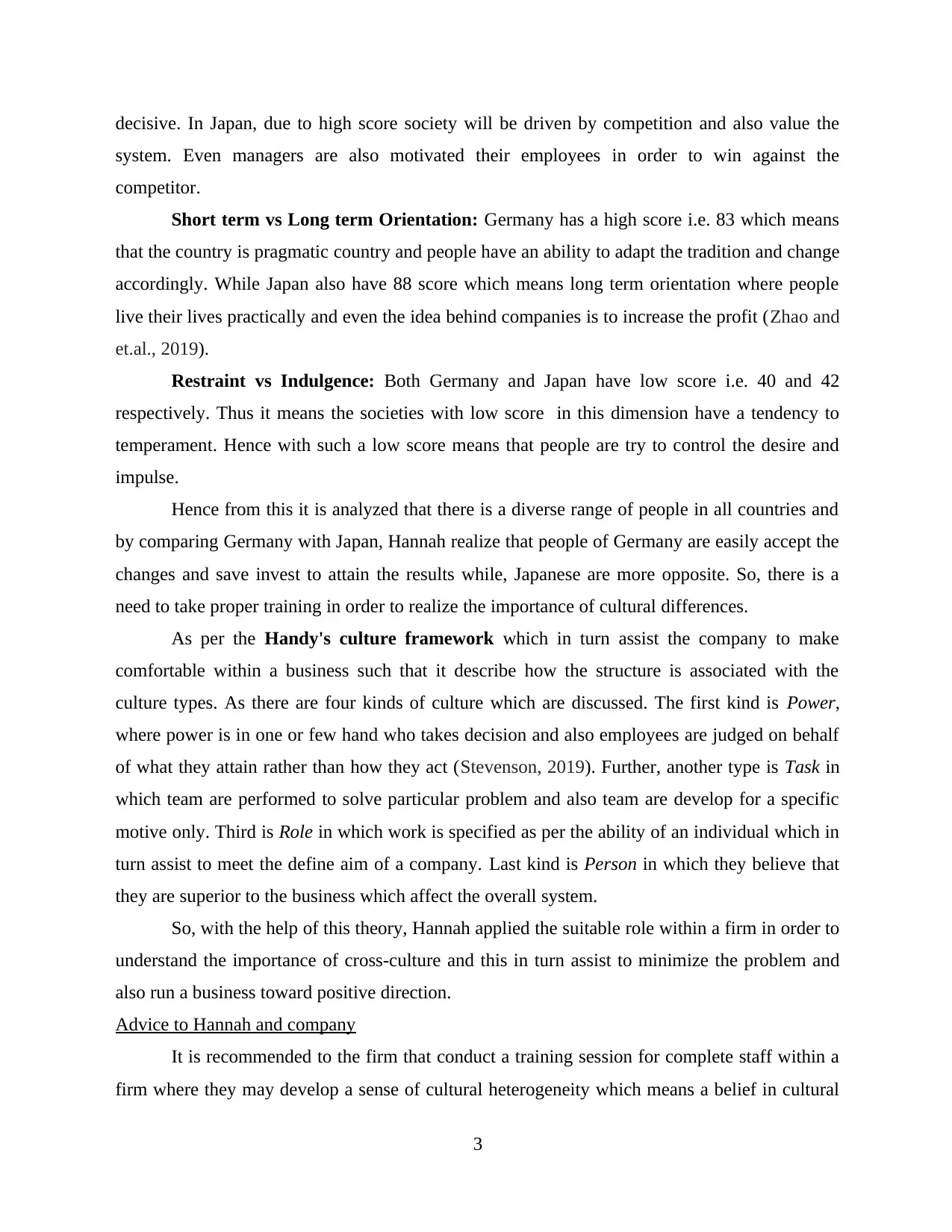
decisive. In Japan, due to high score society will be driven by competition and also value the
system. Even managers are also motivated their employees in order to win against the
competitor.
Short term vs Long term Orientation: Germany has a high score i.e. 83 which means
that the country is pragmatic country and people have an ability to adapt the tradition and change
accordingly. While Japan also have 88 score which means long term orientation where people
live their lives practically and even the idea behind companies is to increase the profit (Zhao and
et.al., 2019).
Restraint vs Indulgence: Both Germany and Japan have low score i.e. 40 and 42
respectively. Thus it means the societies with low score in this dimension have a tendency to
temperament. Hence with such a low score means that people are try to control the desire and
impulse.
Hence from this it is analyzed that there is a diverse range of people in all countries and
by comparing Germany with Japan, Hannah realize that people of Germany are easily accept the
changes and save invest to attain the results while, Japanese are more opposite. So, there is a
need to take proper training in order to realize the importance of cultural differences.
As per the Handy's culture framework which in turn assist the company to make
comfortable within a business such that it describe how the structure is associated with the
culture types. As there are four kinds of culture which are discussed. The first kind is Power,
where power is in one or few hand who takes decision and also employees are judged on behalf
of what they attain rather than how they act (Stevenson, 2019). Further, another type is Task in
which team are performed to solve particular problem and also team are develop for a specific
motive only. Third is Role in which work is specified as per the ability of an individual which in
turn assist to meet the define aim of a company. Last kind is Person in which they believe that
they are superior to the business which affect the overall system.
So, with the help of this theory, Hannah applied the suitable role within a firm in order to
understand the importance of cross-culture and this in turn assist to minimize the problem and
also run a business toward positive direction.
Advice to Hannah and company
It is recommended to the firm that conduct a training session for complete staff within a
firm where they may develop a sense of cultural heterogeneity which means a belief in cultural
3
system. Even managers are also motivated their employees in order to win against the
competitor.
Short term vs Long term Orientation: Germany has a high score i.e. 83 which means
that the country is pragmatic country and people have an ability to adapt the tradition and change
accordingly. While Japan also have 88 score which means long term orientation where people
live their lives practically and even the idea behind companies is to increase the profit (Zhao and
et.al., 2019).
Restraint vs Indulgence: Both Germany and Japan have low score i.e. 40 and 42
respectively. Thus it means the societies with low score in this dimension have a tendency to
temperament. Hence with such a low score means that people are try to control the desire and
impulse.
Hence from this it is analyzed that there is a diverse range of people in all countries and
by comparing Germany with Japan, Hannah realize that people of Germany are easily accept the
changes and save invest to attain the results while, Japanese are more opposite. So, there is a
need to take proper training in order to realize the importance of cultural differences.
As per the Handy's culture framework which in turn assist the company to make
comfortable within a business such that it describe how the structure is associated with the
culture types. As there are four kinds of culture which are discussed. The first kind is Power,
where power is in one or few hand who takes decision and also employees are judged on behalf
of what they attain rather than how they act (Stevenson, 2019). Further, another type is Task in
which team are performed to solve particular problem and also team are develop for a specific
motive only. Third is Role in which work is specified as per the ability of an individual which in
turn assist to meet the define aim of a company. Last kind is Person in which they believe that
they are superior to the business which affect the overall system.
So, with the help of this theory, Hannah applied the suitable role within a firm in order to
understand the importance of cross-culture and this in turn assist to minimize the problem and
also run a business toward positive direction.
Advice to Hannah and company
It is recommended to the firm that conduct a training session for complete staff within a
firm where they may develop a sense of cultural heterogeneity which means a belief in cultural
3
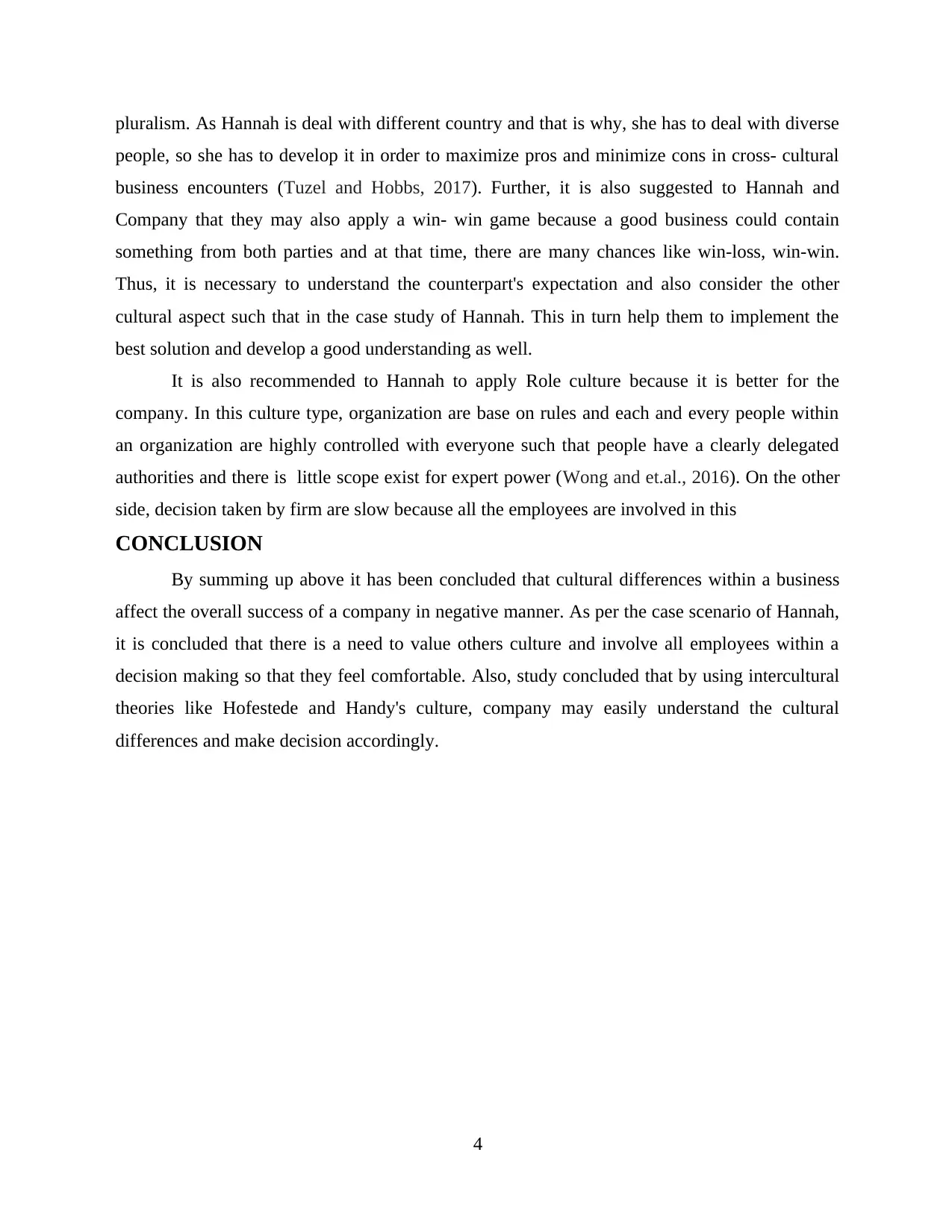
pluralism. As Hannah is deal with different country and that is why, she has to deal with diverse
people, so she has to develop it in order to maximize pros and minimize cons in cross- cultural
business encounters (Tuzel and Hobbs, 2017). Further, it is also suggested to Hannah and
Company that they may also apply a win- win game because a good business could contain
something from both parties and at that time, there are many chances like win-loss, win-win.
Thus, it is necessary to understand the counterpart's expectation and also consider the other
cultural aspect such that in the case study of Hannah. This in turn help them to implement the
best solution and develop a good understanding as well.
It is also recommended to Hannah to apply Role culture because it is better for the
company. In this culture type, organization are base on rules and each and every people within
an organization are highly controlled with everyone such that people have a clearly delegated
authorities and there is little scope exist for expert power (Wong and et.al., 2016). On the other
side, decision taken by firm are slow because all the employees are involved in this
CONCLUSION
By summing up above it has been concluded that cultural differences within a business
affect the overall success of a company in negative manner. As per the case scenario of Hannah,
it is concluded that there is a need to value others culture and involve all employees within a
decision making so that they feel comfortable. Also, study concluded that by using intercultural
theories like Hofestede and Handy's culture, company may easily understand the cultural
differences and make decision accordingly.
4
people, so she has to develop it in order to maximize pros and minimize cons in cross- cultural
business encounters (Tuzel and Hobbs, 2017). Further, it is also suggested to Hannah and
Company that they may also apply a win- win game because a good business could contain
something from both parties and at that time, there are many chances like win-loss, win-win.
Thus, it is necessary to understand the counterpart's expectation and also consider the other
cultural aspect such that in the case study of Hannah. This in turn help them to implement the
best solution and develop a good understanding as well.
It is also recommended to Hannah to apply Role culture because it is better for the
company. In this culture type, organization are base on rules and each and every people within
an organization are highly controlled with everyone such that people have a clearly delegated
authorities and there is little scope exist for expert power (Wong and et.al., 2016). On the other
side, decision taken by firm are slow because all the employees are involved in this
CONCLUSION
By summing up above it has been concluded that cultural differences within a business
affect the overall success of a company in negative manner. As per the case scenario of Hannah,
it is concluded that there is a need to value others culture and involve all employees within a
decision making so that they feel comfortable. Also, study concluded that by using intercultural
theories like Hofestede and Handy's culture, company may easily understand the cultural
differences and make decision accordingly.
4
⊘ This is a preview!⊘
Do you want full access?
Subscribe today to unlock all pages.

Trusted by 1+ million students worldwide
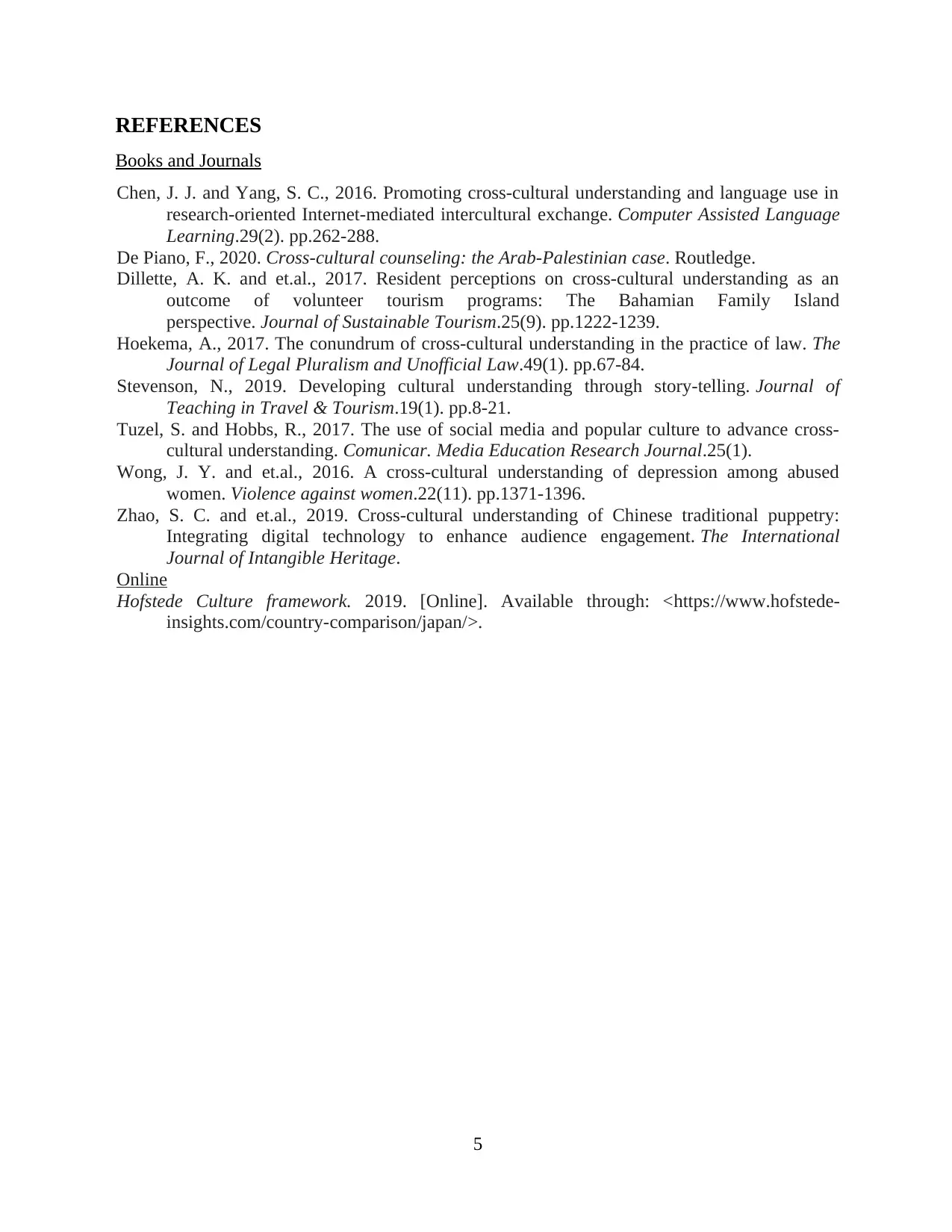
REFERENCES
Books and Journals
Chen, J. J. and Yang, S. C., 2016. Promoting cross-cultural understanding and language use in
research-oriented Internet-mediated intercultural exchange. Computer Assisted Language
Learning.29(2). pp.262-288.
De Piano, F., 2020. Cross-cultural counseling: the Arab-Palestinian case. Routledge.
Dillette, A. K. and et.al., 2017. Resident perceptions on cross-cultural understanding as an
outcome of volunteer tourism programs: The Bahamian Family Island
perspective. Journal of Sustainable Tourism.25(9). pp.1222-1239.
Hoekema, A., 2017. The conundrum of cross-cultural understanding in the practice of law. The
Journal of Legal Pluralism and Unofficial Law.49(1). pp.67-84.
Stevenson, N., 2019. Developing cultural understanding through story-telling. Journal of
Teaching in Travel & Tourism.19(1). pp.8-21.
Tuzel, S. and Hobbs, R., 2017. The use of social media and popular culture to advance cross-
cultural understanding. Comunicar. Media Education Research Journal.25(1).
Wong, J. Y. and et.al., 2016. A cross-cultural understanding of depression among abused
women. Violence against women.22(11). pp.1371-1396.
Zhao, S. C. and et.al., 2019. Cross-cultural understanding of Chinese traditional puppetry:
Integrating digital technology to enhance audience engagement. The International
Journal of Intangible Heritage.
Online
Hofstede Culture framework. 2019. [Online]. Available through: <https://www.hofstede-
insights.com/country-comparison/japan/>.
5
Books and Journals
Chen, J. J. and Yang, S. C., 2016. Promoting cross-cultural understanding and language use in
research-oriented Internet-mediated intercultural exchange. Computer Assisted Language
Learning.29(2). pp.262-288.
De Piano, F., 2020. Cross-cultural counseling: the Arab-Palestinian case. Routledge.
Dillette, A. K. and et.al., 2017. Resident perceptions on cross-cultural understanding as an
outcome of volunteer tourism programs: The Bahamian Family Island
perspective. Journal of Sustainable Tourism.25(9). pp.1222-1239.
Hoekema, A., 2017. The conundrum of cross-cultural understanding in the practice of law. The
Journal of Legal Pluralism and Unofficial Law.49(1). pp.67-84.
Stevenson, N., 2019. Developing cultural understanding through story-telling. Journal of
Teaching in Travel & Tourism.19(1). pp.8-21.
Tuzel, S. and Hobbs, R., 2017. The use of social media and popular culture to advance cross-
cultural understanding. Comunicar. Media Education Research Journal.25(1).
Wong, J. Y. and et.al., 2016. A cross-cultural understanding of depression among abused
women. Violence against women.22(11). pp.1371-1396.
Zhao, S. C. and et.al., 2019. Cross-cultural understanding of Chinese traditional puppetry:
Integrating digital technology to enhance audience engagement. The International
Journal of Intangible Heritage.
Online
Hofstede Culture framework. 2019. [Online]. Available through: <https://www.hofstede-
insights.com/country-comparison/japan/>.
5
1 out of 7
Related Documents
Your All-in-One AI-Powered Toolkit for Academic Success.
+13062052269
info@desklib.com
Available 24*7 on WhatsApp / Email
![[object Object]](/_next/static/media/star-bottom.7253800d.svg)
Unlock your academic potential
Copyright © 2020–2025 A2Z Services. All Rights Reserved. Developed and managed by ZUCOL.





